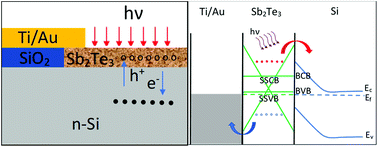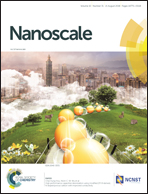A broadband, self-biased photodiode based on antimony telluride (Sb2Te3) nanocrystals/silicon heterostructures†
Abstract
Low bulk band gaps and conductive surface electronic states of tetradymite topological insulators (TTI) make them potential candidates for next generation ultra-broadband photodevices. Here, we demonstrate a broadband and self-biased photodiode based on a Sb2Te3–Si heterostructure. A low-cost thermal evaporation technique was employed to fabricate the photodiode. The self-biased nature of the photodiode was due to the built-in potential at the Sb2Te3–Si interface. Upon characterizing the Sb2Te3 nanocrystalline film via AFM, SEM, EDX, and XPS it was found that the film exhibited p-type behavior due to antimony vacancies or antisites. The fabricated photodiode showed an excellent rectification ratio of 3388 with n-Si confirming a robust Schottky barrier at the interface and a well-defined photocurrent upon illumination. Due to the p-type behavior of the Sb2Te3 nanocrystalline film, a rectification ratio of only 0.38 was observed with p-Si. The barrier at the interface also increases the carrier lifetimes, thereby eliminating one of the biggest drawbacks of ultrafast carrier recombination times in TTI as a photodetection material. Moreover, the photodiode exhibited excellent Ion/Ioff of three orders of magnitude under the self-biased conditions, and photocurrents ranging from 520 nm to 980 nm wavelengths were observed.



 Please wait while we load your content...
Please wait while we load your content...
